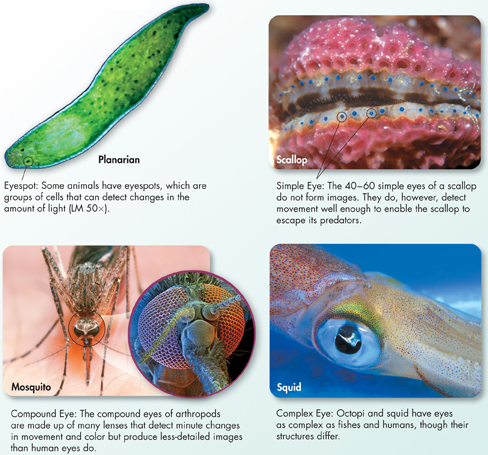Sensory Systems
 What are some types of sensory systems in animals?
What are some types of sensory systems in animals?
The more complex an animal's nervous system is, the more developed its sensory systems tend to be.  Sensory systems range from individual sensory neurons to sense organs that contain both sensory neurons and other cells that help gather information.
Sensory systems range from individual sensory neurons to sense organs that contain both sensory neurons and other cells that help gather information.
Invertebrate Sense Organs Many invertebrates have sense organs that detect light, sound, vibrations, movement, body orientation, and chemicals in air or water. Invertebrate sense organs vary widely in complexity. Flatworms, for example, have simple eyespots that detect only the presence and direction of light. More-cephalized invertebrates have specialized sensory tissues and well-developed sense organs. Some cephalopods and arthropods, for example, have complex eyes that detect motion and color and form images. In Figure 28–6, you can see a variety of invertebrate visual systems.

FIGURE 28–6 Invertebrate Eyes Invertebrate sense organs, such as the eyes shown in the photos, vary greatly in structure and complexity.
dd
Table of Contents
- Formulas and Equations
- Applying Formulas and Equations
- Mean, Median, and Mode
- Estimation
- Using Measurements in Calculations
- Effects of Measurement Errors
- Accuracy
- Precision
- Comparing Accuracy and Precision
- Significant Figures
- Calculating With Significant Figures
- Scientific Notation
- Calculating With Scientific Notation
- Dimensional Analysis
- Applying Dimensional Analysis




